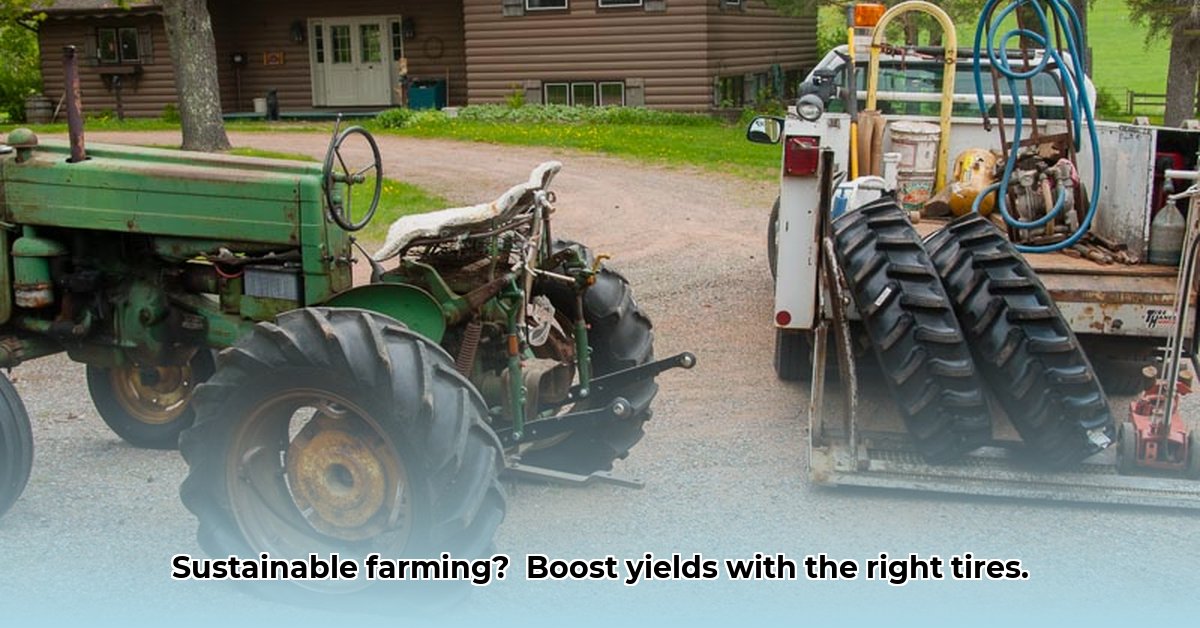
Choosing the right fluid for your tractor tires significantly impacts your farm's efficiency, safety, and environmental footprint. This guide compares common options – water, antifreeze, calcium chloride, beet juice, and windshield washer fluid – helping you make an informed, sustainable decision. For more on tire pressure, see this helpful resource: tire pressure guide.
Understanding the Benefits of Tractor Tire Ballast
Filling your tractor tires with fluid offers several key advantages: enhanced traction (especially on muddy fields or inclines), improved stability (reducing the risk of rollovers), and increased efficiency (allowing you to complete tasks quicker and safer). These benefits translate to a smoother, more productive workday. But how do the various fluid choices stack up?
Comparing Ballast Fluids: A Detailed Analysis
Selecting the ideal fluid hinges on several factors, including climate, soil type, and budget. The following table summarizes the pros and cons of each option, allowing for a comparative assessment.
| Ballast Type | Pros | Cons | Sustainability Rating | Cost | Freeze Resistance | Toxicity |
|---|---|---|---|---|---|---|
| Water | Inexpensive, readily available, environmentally benign. | Freezes in cold temperatures, requires frequent changes. | Excellent | Low | Poor | None |
| Beet Juice | Biodegradable, non-toxic, performs well in moderate climates. | Higher upfront cost, requires careful sourcing and disposal, limited availability in some regions. | Good | Medium | Moderate | None |
| Propylene Glycol Antifreeze | Effective in freezing temperatures, good cold-weather performance. | Moderately toxic, requires careful handling and environmentally responsible disposal. | Moderate | Medium | Excellent | Low |
| Calcium Chloride | Inexpensive, acts as a de-icer. | Extremely corrosive, harmful to the environment, dangerous to handle and dispose of. | Poor | Low | Good | High |
| Windshield Washer Fluid | Readily available, relatively inexpensive. | Contains toxic chemicals, harmful to the environment and human health, inappropriate for tire ballast. | Poor | Low | Varies (depends on formulation) | High |
Do you find yourself frequently changing your ballast due to freezing temperatures? Water's low cost is appealing, yet its poor freeze resistance often necessitates frequent replacements, adding to overall expenses. Consider the long-term costs associated with frequent replacements.
Choosing the Right Fluid for Your Farm: A Practical Guide
The best fluid depends on your specific circumstances. Here's a breakdown to help you choose:
- Water: The most economical and environmentally friendly choice, but unsuitable for cold climates.
- Beet Juice: A sustainable alternative offering a balance between performance and environmental responsibility. This option requires considering availability and disposal methods.
- Propylene Glycol Antifreeze: A suitable option for colder regions, but its toxicity demands careful handling and disposal.
- Calcium Chloride and Windshield Washer Fluid: These should be avoided due to their significant environmental impact and health risks. The corrosive nature of Calcium Chloride can also damage tire components.
Did you know that improper disposal of ballast fluids can significantly impact soil and water quality? Always prioritize environmentally responsible disposal methods.
A Step-by-Step Guide to Filling Your Tractor Tires
Follow these steps for safe and effective tire filling:
- Assess Your Needs: Evaluate your climate, soil type, and workload. This step is crucial for making the right fluid choice.
- Select Your Fluid: Use the table above to identify the most suitable fluid for your conditions.
- Calculate the Required Amount: Use a tire ballast calculator or consult your tractor's manual for precise filling amounts. Overfilling can damage your tires.
- Fill Carefully: Adhere strictly to the manufacturer's instructions and safety precautions.
- Monitor Tire Pressure Regularly: Maintain optimal pressure for safety and performance.
Expert Tip: "Regular pressure checks are vital for maximizing tire lifespan and preventing premature wear," says Dr. Emily Carter, Agricultural Engineer at the University of Minnesota.
Sustainability and the Future of Tractor Tire Ballast
Sustainable farming practices are crucial for long-term profitability and environmental stewardship. Selecting eco-friendly ballast fluids plays a significant role in this commitment. By choosing a less toxic and biodegradable option, you actively contribute to a healthier environment. Further research into sustainable alternatives is underway; stay updated on these advancements. Remember that responsible disposal practices are equally essential.
Choosing Sustainable Ballast for Cold Climates: In-Depth Considerations
Key Considerations for Cold Climates:
- Freeze Point: The fluid's freeze point is paramount in colder regions. Water is unsuitable, while propylene glycol antifreeze provides excellent freeze protection.
- Environmental Impact: Even in cold climates, minimizing the environmental footprint remains a priority. Consider the long-term consequences of using potentially harmful chemicals.
- Cost Analysis: Factor in not only the initial cost of the fluid but also the long-term expenses, including potential disposal costs.
Expert Insight: "The transition to sustainable practices is a long-term investment, impacting your farm's environmental footprint and potentially opening doors to new market opportunities. The shift is well worth the initial cost," explains Dr. John Miller, Professor of Sustainable Agriculture at Cornell University.
This guide offers a comprehensive framework for selecting the best sustainable liquid tractor tire ballast, balancing cost, performance, and environmental responsibility. Remember that the optimal choice depends on your individual circumstances and priorities.